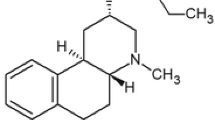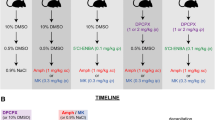Summary
Water intake in water deprived rats was decreased by administration of a low dose of apomorphine (0.1 mg/kg s.c.). This dose is too low to induce hyperactivity and stereotypies. Four different dopamine (DA) D-2 antagonists were used to counteract this effect of apomorphine; haloperidol [an antipsychotic inducing extrapyramidal side-effects (EPS)], sulpiride (an antipsychotic inducing less EPS than haloperidol), metoclopramide (not used as an antipsychotic but inducing EPS) and domperidone (not passing through the blood brain barrier). Domperidone did not counteract the apomorphine effect, indicating a central mechanism of action for apomorphine. Metoclopramide did not counteract the apomorphine effect and, in higher doses, water intake was even further reduced. Sulpiride completely counteracted the apomorphine effect but, in higher doses, did not by itself reduce water intake. Haloperidol counteracted the apomorphine effect in a small dose-range and caused a further reduction in the water intake when given in high doses. The results can be explained by the existence of two subpopulations of D-2 receptors related to different functions. The model described may be used in screening experiments aimed at finding new antipsychotic drugs with a low incidence of EPS.
Similar content being viewed by others
References
Arnt J (1982) Pharmacological specificity of conditioned avoidance response inhibition in rats: inhibition by neuroleptics and correlation to dopamine receptor blockade. Acta Pharmacol Toxicol 51: 321–329
Barzaghi F, Groppetti A, Mantegazza P, Muller EE (1973) Reduction of food intake by apomorphine: a pimozid-sensitive effect. J Pharm Pharmacol 25: 909–911
Beninger RJ (1983) The role of dopamine in locomotor activity and learning. Brain Res Rev 6: 173–196
Beninger RJ, Cheng M, Hahn GL, Hoffman DC, Mazurski EJ, Morency MA, Ramm P, Stewart RJ (1987) Effects of extinction, pimozide, SCH 23390, and metoclopramide on food-rewarded operant responding of rats. Psychopharmacology 92: 343–349
Borenstein P, Bles G (1965) Effects cliniques et électroencéphalo-graphiques de metoclopramide en psychiatrie. Thérapie 20: 975–995
Bradbury AJ, Costall B, Lim SK, Naylor RJ (1982) Reduction in spontaneous locomotor activity by purported dopamine agonists: An analysis of the site and mechanism of action. In: Kohsaka M, Shohmori T, Tsukuda Y, Woodruff GN (eds) Advances in dopamine research. Pergamon Press, Oxford, pp 413–424
Carnoy P, Ravard S, Wemerman B, Soubrie P, Simon P (1986a) Behavioral deficits induced by low doses of apomorphine in rats: evidence for a motivational and cognitive dysfunction which discriminates among neuroleptic drugs. Pharmacol Biochem Behav 25: 503–506
Carnoy P, Soubrie P, Peuch AJ, Simon P (1986b) Performance deficit induced by low doses of dopamine agonists in rats. Toward a model for approaching the neurobiology of negative schizophrenic symptomatology? Biol Psychiatry 21: 11–22
Colpaert FC, van Bever VFM, Leysen JEM (1976) Apomorphine: chemistry, pharmacology and biochemistry. Int Rev Neurobiol 19: 225–268
Costall B, Eniojukan JF, Naylor R (1983) The mesolimbic nucleus accumbens is critically involved with the mediation of the motor inhibition and facilitatory effects of dopamine agonists on mouse spontaneous climbing behaviour. Eur J Pharmacol 96: 201–210
Di Chiara G, Porceddu ML, Vargiu L, Argiolas A, Gessa GL (1976) Evidence for dopamine receptors mediating sedation in the mouse brain. Nature 264: 564–567
Dourish CT (1983) Dopaminergic involvement in the control of drinking behaviour: a brief review. Prog Neuropsychopharmacol Biol Psychiatry 7: 487–493
Dourish CT, Cooper SJ (1981) Single or repeated administration of small doses of apomorphine on water intake and activity in water-deprived rats. Neuropharmacology 20: 257–260
Dourish CT, Cooper SJ (1985) Behavioural evidence for the existance of dopamine autoreceptors. TIPS 1: 17–18
Gerlach J, Behnke K, Heltberg J, Munk-Andersen E, Nielsen H (1985) Sulpiride and haloperidol in schizophrenia: a double-blind cross-over study of the therapeutic effect, side effects and plasma concentrations. Br J Psychiatry 147: 283–288
Gower AJ, Berendsen HHG, Princen MM, Broekkamp CLE (1984) The yawning-penile erection syndrome as a model for putative dopamine autoreceptor activity. Eur J Pharmacol 103: 81–89
Janssen PAJ, Niemegeers CJE, Schellekens KHL (1965) Is it possible to predict the clinical effects of neuroleptic drugs (Major Tranquillizers) from animal data? Arzneimittelforschung 15: 104–117
Jenner P, Marsden CD (1981) Substituted benzamide drugs as selective neuroleptic agents. Neuropharmacology 20: 1285–1293
Kebabian JW, Calne DB (1979) Multiple receptors for dopamine. Nature 277: 93–96
Kendler KS, Bracha HS, Davies KL (1982) Dopamine autoreceptor and postsynaptic receptor blocking potency of neuroleptics. Eur J Pharmacol 79: 217–223
Laduron PM, Leysen JE (1979) Domperidone, a specific in vitro dopamine antagonist, devoid of in vivo central dopaminergic activity. Biochem Pharmacol 28: 2161–2165
Ljungberg T (1979) Evidence that time related changes in apomorphine stimulation determine the behavioural response. Neuropharmacology 18: 327–334
Ljungberg T (1987) Blockade by neuroleptics of water intake and operant responding for water in the rat: anhedonia, motor deficit or both? Pharmacol Biochem Behav 27: 341–350
Ljungberg T (1988) Scopolamine reverses haloperidol-attenuated lever-pressing for water but not haloperidol-attenuated water intake in the rat. Pharmacol Biochem Behav 29: 205–208
Ljungberg T, Ungerstedt U (1976) Automatic registration of behaviour related to dopamine and noradrenaline transmission. Eur J Pharmacol 36: 181–188
Ljungberg T, Ungerstedt U (1977) Different behavioural patterns induced by apomorphine: evidence that the method of administration determines the behavioural response to the drug. Eur J Pharmacol 46: 41–50
Ljungberg T, Ungerstedt U (1978) Classification of neuroleptic drugs according to their ability to inhibit apomorphine-induced locomotion and gnawing: evidence for two different mechanism of action. Psychopharmacology 56: 239–247
Misslin R, Ropartz P, Jung L (1984) Impairment of responses to novelty by apomorphine and its antagonism by neuroleptics in mice. Psychopharmacology 82: 113–117
Mogilnicka E, Boissard CG, Delini-Stula A (1984) Effects of apomorphine, TL-99 and 3- PPP on yawning in rats. Neuropharmacology 23: 19–22
Muscat R, Willner P, Towell A (1986) Apomorphine anorexia: a further pharmacological characterization. Eur J Pharmacol 123: 123–131
Nakajima S, McKenzie GM (1986) Reduction of the rewarding effect of brain stimulation by a blockade of dopamine D 1 receptor with SCH 23390. Pharmacol Biochem Behav 24: 919–923
Nielsen EB, Lyon M (1973) Drinking behaviour and brain dopamine: antagonistic effect of two neuroleptic drugs (pimozide and spiramide) upon amphetamine- or apomorphine-induced hypodipsia. Psychopharmacologia 33: 299–308
ögren S-O, Hall H, Köhler C, Magnusson O, Sjöstrand S-E (1986) The selective dopamine D 2 receptor antagonist raclopride discriminates between dopamine-mediated motor functions. Psychopharmacology 90: 287–294
ögren S-O, Rodebjer A, Ängeby K (1984) The “presynaptic” blocking potency of sulpiride and haloperidol in the rat is age-dependent. Neurosci Lett 46: 203–207
Protais P, Dubuc I, Costentin J (1983) Pharmacological characteristics of dopamine receptors involved in the dual effect of dopamine agonists on yawning behaviour in rats. Eur J Pharmacol 94: 271–280
Puech AJ, Simon P, Chermat R, Boissier JR (1974) Profil neuropsychopharmacologique de l'apomorphine. J Pharmacol (Paris) 5: 241–254
Reyntjens AR, Niemegeers CJE, Van Nueten JM, Laduron P, Heykants J, Schellekens KHL, Marsbom R, Jageneau A, Broekaert A, Janssen PAJ (1978) Domperidone, a novel and safe gastrokinetic anti-nauseant for the treatment of dyspepsia and vomiting. Arzneimittelforschung 28: 1194–1196
Schwartz J-C, Delandre M, Martres MP, Sokoloff P, Protais P, Vasse M, Costentin J, Laibe P, Mann A, Wermuth CG, Gulat G, Lafitte A (1984) Biochemical and behavioural identification of discrimant benzamide derivatives: new tools to differentiate subclasses of dopamine receptors. In: Usdin E, Carlsson A, Dahlström A, Engel J (eds) Catecholamines: neuropharmacology and central nervous system—theoretical aspects. Alan R Liss, New York, pp 59–72
Seeman P (1980) Brain dopamine receptors. Pharmacol Rev 32: 229–313
Serra G, Van Ree JM, de Wied D (1983) Influence of classical and atypical neuroleptics on apomorphine-induced behavioural changes and on extinction of a conditioned avoiance respons. J Pharm Pharmacol 35: 255–257
Serra G, Collu M, Gessa GL (1986) Dopamine receptors mediating yawning: are they autoreceptors? Eur J Pharmacol 120: 187–192
Strömbom U (1976) Catecholamine receptor agonists: Effects on motor activity and tyrosine hydroxylation in mouse brain. Naunyn Schmiedebergs Arch Pharmacol 292: 167–176
Ståhle L (1987) Pharmacological studies on behavioural changes induced by dopamine agonists in the rat: a multivariate approach. Thesis, Karolinska Institute, Stockholm, Sweden
Ståhle L, Ungerstedt U (1984) Assessment of dopamine autoreceptor agonist properties of apomorphine, (+)-3-PPP and (−)-3-PPP by recording of yawning behaviour in rats. Eur J Pharmacol 98: 307–310
Ståhle L, Ungerstedt U (1986a) Different behavioural patterns induced by the dopamine agonist apomorphine analysed by multivariate statistics. Pharmacol Biochem Behav 24: 291–298
Ståhle L, Ungerstedt U (1986b) Effects of neuroleptic drugs on the inhibition of exploratory behaviour induced by a low dose of apomorphine: implications for the identity of dopamine receptors. Pharmacol Biochem Behav 25: 473–480
Towell A, Muscat R, Willner P (1986) Apomorphine anorexia: the role of dopamine cell body autoreceptors. Psychopharmacology 89: 65–68
Vaccheri A, Dall'Olio R, Gandolfi O, Montanaro N (1986) Involvement of different dopamine receptors in rat diphasic motility response to apomorphine. Psychopharmacology 89: 265–268
Willner P, Towell A, Muscat R (1985) Apomorphine anorexia: a behavioural and neuropharmacological analysis. Psychopharmacology 87: 351–356
Wise RA (1982) Neuroleptics and operant behavior, the anhedonia hypothesis. Behav Brain Sci 5: 39–87
Wonnacot TH, Wonnacot RJ (1977) Introductory statistics. Wiley, New York
Worms P, Lloyd KG (1979) Predictability and specificity of behavioural screening tests for neuroleptics. Pharmacol Ther 5: 445–450
Yamada K, Furukawa T (1980) Direct evidence for involvement of dopaminergic inhibition and cholinergic activation in yawning. Psychopharmacology 67: 39–43
Yamada K, Tanaka M, Shibata K, Furukawa T (1986) Involvement of septal and striatal dopamine D-2 receptors in yawning behavior in rats. Psychopharmacology 90: 9–13
Author information
Authors and Affiliations
Rights and permissions
About this article
Cite this article
Ljungberg, T. Dopamine D-2 antagonists reverse apomorphine-induced decreased water intake in the rat: prediction of antipsychotic drugs with few extrapyramidal side-effects?. J. Neural Transmission 76, 79–90 (1989). https://doi.org/10.1007/BF01578748
Received:
Accepted:
Issue Date:
DOI: https://doi.org/10.1007/BF01578748




